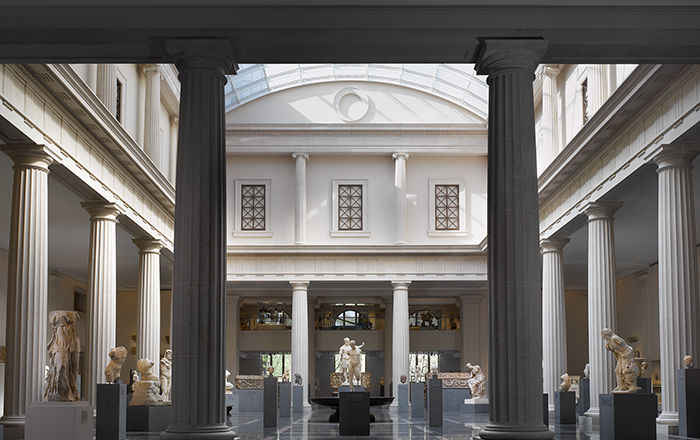On loan to The Met The Met accepts temporary loans of art both for short-term exhibitions and for long-term display in its galleries.
Marble female figure
Technical analysis: Ultraviolet-induced visible luminescence, optical microscopy
The figure is complete, but fractures across the knees and in the proper right ankle that have been repaired indicate the statuette was broken at some point. A modern fill was used to restore a large loss on the front of the proper left thigh and the tip of the proper left foot, and modern paint was used to disguise the fills and fractures in the legs. Reddish brown deposits found mainly on the front on proper left side and between the legs suggest the figure was placed face-down. A light-colored abrasion is found at the waist on the proper right side. No readily visible evidence of pigments was found on the surface.
The figure features a relatively long U-shaped face with a delicate low-placed nose and a rather short neck. The shoulders are rounded, and the arms with the elbows held against the body are folded in the canonical left-over-right arrangement. The lower abdomen terminates in a gently curving horizontal groove that marks the top of the thighs and the beginning of a deep leg-cleft, which is perforated from above the knees to the mid-calves. The cleft distinguishing the legs on the back is relatively shallow above. The feet are completely separated. The spine is represented by a vertical groove on the back. The posture is standard, with the knees slightly flexed, the feet angled down and outward, and the head tilted slightly back toward the crown.
Although no ancient paint is preserved, there are possible paint ghosts in the form of light areas across the forehead for a polos, the beginning of a right sideburn, and possibly the right eye, which would have originally been painted.
The relatively small but carefully carved figure with gently curving contours is an excellent example of the Early Spedos type produced in some quantity around the middle of the third millennium BCE. All of the smaller figures and some of the larger works in this stylistic group are also characterized by the absence of incised fingers and toes.
Alexis Belis and J-F de Lapérouse
This image cannot be enlarged, viewed at full screen, or downloaded.
This artwork is meant to be viewed from right to left. Scroll left to view more.






